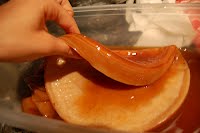What is a Kombucha Scoby

A kombucha culture (also refered to as a Scoby) looks a little like a pancake although its appearance will change once it is used to brew with. It is generally a creamy white colour however if used to brew in Indian or Black tea its colour will darken due to the tannins in the tea. Kombucha cultures will regenerate everytime they are used to brew with and will therefore provide you with a lifetime supply of Scobies and Kombucha if well looked after. The culture itself is a combination of candida friendly yeasts and bacteria.
Now for the science bit:
The name Scoby comes from the Acronym Symbiotic Colony of Bacteria and Yeast. Kombucha cultures are occasionally refered to as mushrooms (however they are not fungee) and also the mother of vinegar, mother cultures… the list goes on. The culture itself is scientifically referred to as a Zoogleat Mat and a Kombucha Scoby will take on the shape of the container.The thickness of a culture is determined by the acidity of the medium during the development period and how long it has been left to develop.
the yeast(s) contained in kombucha may often contain any of saccharomyces cerevisiae, brettanomyces bruxellensis, candida stellata, schizosaccharomyces pombe, torulaspora delbrueckii, andzygosaccharomyces bailii, or another domesticated strain however this will vary from culture to culture, alcohol production by the yeast(s) contributes to the production of acetic acid by the bacteria present. The alcohol concentration also plays a role in triggering cellulose production by the bacterial symbionts.
The Bacteria contained in a Kombucha Mother Scoby usually consists of several different species but will always contain gluconacetobacter xylinus (formerly acetobacter xylinum), this is responsible for fermenting the alcohol produced by the yeast(s) into acetic acid, this increases the acidity of Kombucha while limiting the general alcoholic content.
The acidic and mild alcoholic content of Kombucha means that it is able to resist contamination by most airbourne mould or bacteria spores, this means that Kombucha is generally easy to maintain as a culture outside sterile conditions. Simple good food hygiene practice is all that is required.

